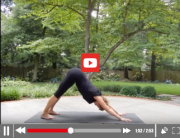I’m the only person I know who actually uses and shares on a daily basis the information I explored in my doctoral thesis — how to cultivate resilience, that resourceful, persevering ability to cope effectively with daily stresses and successfully adapt to loss, adversity, conflict and other struggles of life.
The cultivation of mindfulness is one of the most practical ways I know to boost resilience. Studies show that mindfulness is a powerful way to take a break from stressful thoughts and gain perspective before you react or respond … but there’s nothing like seeing it in my clients or experiencing it for myself to make me a true believer in the power of mindfulness.
When I started my own mindfulness practice over twenty years ago, I would never have believed what the research (and my own experience) now shows — people who exhibit greater mindfulness tend to enjoy greater satisfaction and intimacy in relationships and deal with relationship stress more constructively.
Interested? Here are three ways that you can quickly and easily begin to translate the mind-body benefits of mindfulness into your everyday life and relationships.
Mindful Breathing
It’s not surprising that researchers have found that people who were more mindful throughout the day tended to also show enhanced self-awareness, were more able to regulate their behavior, and reported more positive emotional states.
Don’t be fooled by the simplicity of mindful breathing — it is a very powerful stress reduction practice. Studies have found that mindful breathing has a profound effect on your physiology and can improve sleep and energy cycles, decrease anxiety, lower blood pressure, and even correct heart arrhythmias.
The Calming Breath is a very effective technique to help release stress and refocus mentally. The Calming Breath Part 1 is a simple ratio breath of inhaling to a count of 4 and exhaling to a count of 8. The Calming Breath Part 2 includes breath retention and is even more powerful. Once you’re very comfortable with The Calming Breath Part 1, you may want to try Part 2.
If you’d like a brief, guided experience of The Calming Breath Part 1 and The Calming Breath Part 2, I’ve posted two podcasts in MP3 format in the Blogs/Podcasts section of my website. Each podcast lasts about 5 minutes. Use them when you need to relax, refresh and refocus mentally and physically.
Mindfulness Meditation
Mindful breathing cultivates the ability to concentrate in a relaxed way and provides a gateway to the added benefits of a mindfulness meditation practice. As therapist and author Stephen Cope puts it, meditation creates “a container to hold life in such a way that we are not shattered by it.” It’s true — mindfulness helps us tolerate and explore subjective experiences that may be uncertain, unfamiliar, uncomfortable, and paradoxical. It’s not surprising that researchers have found that people who were more mindful throughout the day tended to also show enhanced self-awareness, were more able to regulate their behavior, and reported more positive emotional states.
How to start? I recommend that you practice The Calming Breath until you’re ready to spend 10 to 20 minutes in a comfortable seated or reclining position in meditation. Most beginners seem to do better with a structured experience, whether it’s a meditation class or a guided experience to listen to at home. For my clients, I recorded a CD that is now available on iTunes and Amazon MP3 called Mindfulness-Based Stress Reduction: Four Guided Experiences by Dr. Jan. Clients use these guided meditations to help get to sleep, prepare mentally and emotionally for upcoming events, help manage chronic pain — or just chill.
Mindful Walking

What’s the best way to cultivate a mindfulness practice if sitting, uninterrupted and undisturbed, for 10 to 20 minutes is simply not going to happen anytime soon in your life? Most of us have to deal with an “Inner Pusher” voice inside us that insists that we constantly be in a state of doing versus being. Besides, most of us are already plenty sedentary.
For some of my clients, a better place to start is with Mindful Walking. I modified this practice from the classical walking meditation (which involves walking extremely slowly and methodically) into a more practical experience that can be done almost anywhere. Translation: No one will mistake you for a zombie — you’ll be able to do this in public.
Begin your walk with a sense of gratefulness for the opportunity to cultivate mindfulness. Let your intention be to focus visually enough to be aware of your surroundings, but not distracted by them. As you walk along, let your attention rest on any or all of the following three awareness “anchors” that are connected to present moment experience: 1) sounds in your environment; 2) your breathing; and 3) sensations in your body. Whenever your attention wanders from one of these three awareness anchors, exchange “thinking” for “sensing” of sound, breath or body … and feel yourself returning to the here and now.
If you have ADD, I recommend that you stay with and return to just one anchor and make a conscious decision about when to pick another one. This variation will strengthen your ability to focus and make transitions.

































